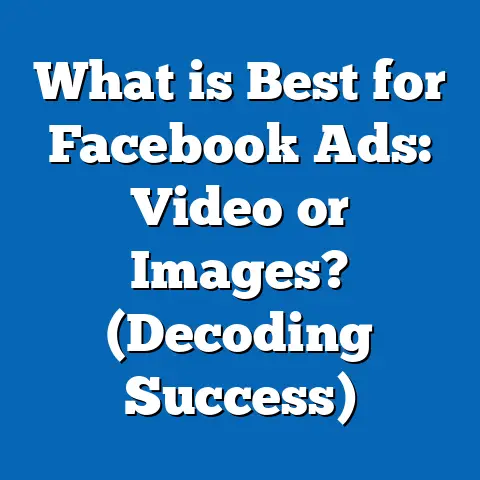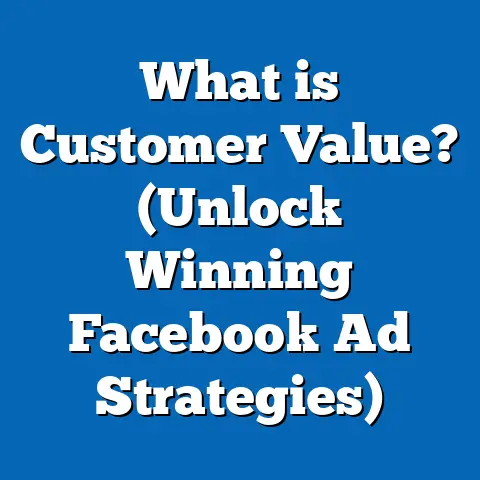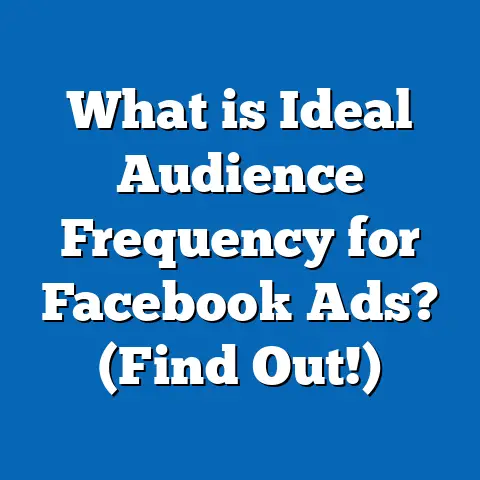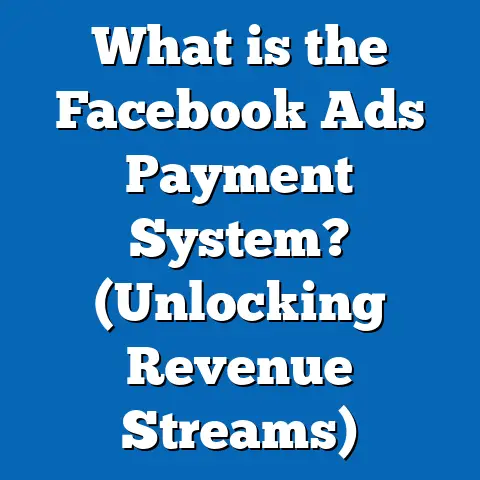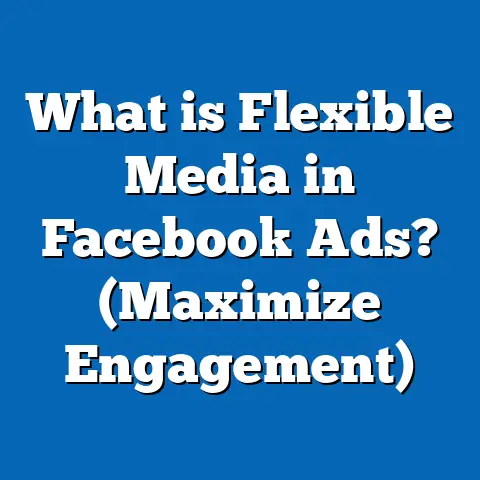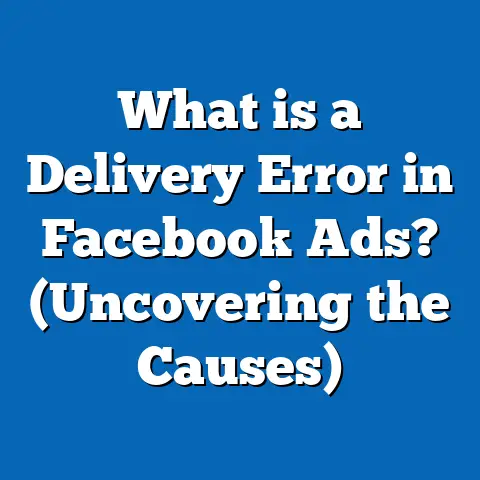What is Facebook for Android (Decoding Pop-Up Ads)?
Introduction: The Visual Pulse of Facebook for Android
In the digital world, aesthetics are more than just a visual delight; they form a core part of how users experience and interact with technology. Facebook for Android exemplifies this principle, offering a sleek, intuitive platform that connects billions globally. However, beyond the smooth user interface lies a sophisticated advertising ecosystem, with pop-up ads playing a key role.
These pop-up ads are not just interruptions; they are strategic components designed to capture user attention and drive conversions. Understanding these ads—how they work, their impact, and how to use them effectively—is essential for marketers who want to thrive in mobile advertising.
What is Facebook for Android?
Facebook for Android is the mobile application version of the Facebook social network tailored specifically for Android smartphones and tablets. It provides users with access to Facebook’s full suite of social networking features optimized for mobile use.
Core Features of Facebook for Android
- User-Centric Interface: Designed for various screen sizes and resolutions, offering a seamless browsing experience.
- Integrated Advertisement Platform: Displays various ad formats including pop-up ads, native ads, video ads, and more.
- Real-Time Engagement: Push notifications and alerts keep users connected with friends and brands.
- Data Optimization: Efficient performance even on slower networks or older devices ensures wide accessibility.
- Social Commerce Capabilities: Enables direct interaction with businesses via shops, messages, and ads.
Market Reach and Usage Statistics
- As of early 2024, Facebook boasts around 2.9 billion monthly active users worldwide.
- Over 70% of these users access Facebook via mobile devices, highlighting the critical importance of mobile optimization.
- Android holds approximately 75% of the global smartphone OS market share, making Facebook for Android the dominant mobile access point.
- Daily active users on Facebook for Android number approximately 1.8 billion, underscoring its massive audience potential.
These statistics show that Facebook for Android is not just an app; it’s a massive platform where advertising can reach highly targeted audiences at scale.
Understanding Pop-Up Ads on Facebook for Android
Pop-up ads on Facebook for Android refer to advertisements that appear as overlay windows on the user’s screen. Unlike banner ads that blend into content or native ads that match the app’s look and feel, pop-ups demand immediate attention by temporarily taking over the screen or a portion of it.
Types of Pop-Up Ads Found on Facebook for Android
1. Interstitial Ads
These are full-screen ads presented between app activities or natural transition points. For example, an interstitial might appear after a user finishes reading a post or before navigating to another section.
Key Characteristics:
- Full-screen coverage.
- High visibility and engagement.
- Usually displayed at natural breaks to avoid disrupting user flow.
- Often used with rich media such as videos or interactive content.
2. Modal Pop-Ups
Modal pop-ups are smaller overlay windows that appear on top of the current screen but cover only part of it. They usually require user action to close or interact with.
Key Characteristics:
- Partial screen coverage.
- Interactive elements like buttons or forms.
- Used for quick calls-to-action (e.g., newsletter signups, discount offers).
3. Rewarded Pop-Up Ads
These are interactive ads offering users incentives—like extra game lives or discounts—in exchange for viewing the ad fully.
Key Characteristics:
- Users opt-in to view.
- Often used in gaming or shopping apps.
- High engagement due to incentive-driven participation.
Why Facebook Uses Pop-Up Ads on Android
Pop-up ads are integral because they:
- Maximize Visibility: Due to their screen dominance, they command user focus immediately.
- Increase Engagement: They boost interaction rates compared to other ad formats.
- Offer Rich Media Experience: Can include videos, carousels, quizzes, and other interactive elements.
- Support Precise Targeting: Combined with Facebook’s advanced algorithms, they reach highly relevant audiences.
The Psychology Behind Pop-Up Ads
Pop-ups can be polarizing; while some users find them intrusive, others respond positively if the ad is relevant and well-timed. Understanding the psychology behind pop-up ads helps marketers design campaigns that engage rather than annoy users.
Attention Capture
Pop-ups interrupt the usual user flow but do so purposefully at moments where attention can be maximized. When timed correctly (e.g., after content consumption or during natural pauses), pop-ups benefit from heightened user focus.
Perceived Value
Users tolerate pop-ups better when there’s perceived value—whether a discount, exclusive content, or entertainment. Rewarded pop-ups capitalize on this by exchanging value for engagement.
Scarcity and Urgency
Many pop-up ads use urgency cues (“Limited time offer”) or scarcity (“Only 3 left!”) to prompt immediate action. This taps into decision-making heuristics that accelerate conversions.
Data-Backed Insights on Pop-Up Ad Performance
Engagement Performance Metrics
According to the Mobile Marketing Association’s 2023 report:
- Interstitial pop-up ads deliver an average click-through rate (CTR) of 4.2% on mobile platforms.
- This outperforms traditional banner ads which average only about 1.8% CTR.
- Pop-up ad conversion rates can be as much as 28% higher than desktop-based counterparts due to mobile immediacy.
User Behavior Insights
Facebook’s own internal research (2024) shows:
- Users exposed to well-targeted pop-up ads spent 15% more time on the app during sessions.
- Proper frequency capping reduces ad fatigue and keeps brand favorability high.
- Negative feedback (ad hides or complaints) drops significantly when pop-ups are contextually relevant and infrequent.
Cost Efficiency and ROI
Marketers report:
- Pop-up ads have a generally higher cost per impression due to prominence but often yield better ROI because of superior engagement.
- Campaigns using pop-ups see an average return on ad spend (ROAS) increase by 20%-35% compared to other mobile ad formats.
Technical Overview: How Pop-Up Ads Operate Within Facebook for Android
Understanding the technical underpinnings offers deeper insight into why these ads perform well.
1. Ad Targeting Algorithms
Facebook leverages vast amounts of user data—behavioral patterns, demographic info, interests—to deploy highly targeted pop-up ads. Machine learning models predict which users are most likely to engage with particular ads based on prior interactions and contextual signals like time of day or device type.
2. Real-Time Auction System
Facebook runs a real-time bidding auction where advertisers compete to have their ad shown as a pop-up. The system balances bid amount with estimated ad quality and relevance scores to determine winners.
3. Rendering Engine
The Facebook app uses a native rendering engine optimized for fast loading and smooth transitions. This ensures that even rich media pop-ups load quickly without causing lag or crashes.
4. Tracking & Analytics Integration
Every interaction—impression views, clicks, dismissals—is logged and fed back into analytics systems. This data constantly refines targeting algorithms and helps advertisers optimize campaigns in near real-time.
Case Study: FreshFit Nutrition’s Explosive Growth via Pop-Up Ads
Background
FreshFit Nutrition is a startup offering personalized fitness tracking and nutrition advice through a mobile app. Their goal was to increase app downloads and paid subscriptions among health-conscious Android users in North America.
Dynamic Creative Optimization (DCO)
AI tools automatically generate multiple versions of an ad by mixing headlines, images, CTAs, etc., then serve the best-performing combinations dynamically based on real-time data.
Predictive Analytics
Machine learning models forecast when users are most receptive to pop-up ads by analyzing behavioral patterns such as app usage times, past interactions, and device activity logs.
Personalized Ad Delivery
Ads are customized individually using signals gathered from prior engagements, shopping behaviors, social actions, and preferences allowing hyper-targeted messaging that drives stronger results.
Emerging Trends Impacting Facebook Pop-Up Advertising
1. Privacy Changes & Data Regulation
With regulations like GDPR (Europe) and CCPA (California), advertisers navigate stricter rules on data collection and targeting. Facebook adapts by emphasizing privacy-first models such as aggregated event measurement and limiting personal data usage while maintaining targeting effectiveness.
2. Growing Mobile Dominance Worldwide
Mobile internet usage continues climbing globally—especially in emerging markets where Android dominates—making mobile-first platforms like Facebook crucial channels for growth-oriented marketers.
3. Interactive & Gamified Ads
Innovations include AR filters within pop-ups and mini-games that increase engagement by turning ads into experiences rather than messages.
4. Cross-Platform Campaign Integration
Advertising strategies increasingly unify messaging across Facebook, Instagram, Messenger, and WhatsApp — all under Meta’s umbrella — using data synergy to reinforce brand presence through multiple touchpoints including pop-ups.
Step-by-Step Guide: Launching Your First Facebook Pop-Up Ad Campaign on Android
- Define Your Campaign Goals: Decide if you want awareness, leads, app installs, or sales.
- Identify Your Audience: Use Facebook Audience Manager for detailed segmentation based on demographics, interests, behavior.
- Create Compelling Creatives: Design eye-catching visuals optimized for mobile screens with concise copy.
- Choose Your Ad Format: Select interstitial or modal pop-ups based on your campaign objectives.
- Set Budget & Bidding Strategy: Choose daily or lifetime budgets; consider cost-per-click (CPC) or cost-per-thousand-impressions (CPM).
- Configure Ad Placement: Opt for automatic placements targeting Facebook app on Android devices specifically for better relevance.
- Implement Frequency Capping: Limit number of times each user sees your ad per session/day.
- Launch & Monitor: Use Facebook Ads Manager dashboard to track impressions, CTRs, conversions in real-time.
- Optimize Based on Data: Adjust creatives, targeting, timing based on performance analytics regularly.
Common Challenges & How to Overcome Them
Challenge: User Annoyance Leading to Negative Feedback
Solution: Use frequency capping; ensure relevance through precise targeting; avoid repetitive messaging.
Challenge: Slow Loading Times Affecting User Experience
Solution: Optimize ad creatives for size; use lightweight formats; test loading speed during development.
Challenge: Privacy Restrictions Impacting Targeting Accuracy
Solution: Use broader audience segments combined with contextual signals; experiment with lookalike audiences; stay updated with platform policy changes.
Summary of Key Takeaways
- Facebook for Android is a dominant platform with billions of daily active users ideal for mobile advertising.
- Pop-up ads include interstitials, modal overlays, and rewarded formats designed for high visibility.
- These ads deliver superior engagement metrics compared to banners or native formats when timed and targeted well.
- Technical sophistication in ad delivery leverages machine learning to optimize relevance and performance dynamically.
- Successful campaigns rely on clear objectives, creative excellence, precise audience segmentation, timing strategies, and ongoing optimization.
- Emerging trends around privacy and interactivity will shape future opportunities in mobile pop-up advertising.
Final Thoughts: Maximizing Your Marketing Potential with Facebook Pop-Up Ads on Android
Mastering pop-up ads on Facebook for Android means balancing visibility with user experience while leveraging advanced targeting tools provided by Meta’s ecosystem. When integrated thoughtfully into your marketing strategy, these ads can become powerful conversion drivers that grow your business efficiently in today’s mobile-first world.
Start small with well-planned tests, learn from each campaign’s performance data, then scale up successful tactics confidently. The future of mobile advertising is here—and understanding how to decode and deploy pop-up ads effectively will set you apart in a crowded marketplace.
If you want me to provide examples of creative templates or detailed setup guides in Facebook Ads Manager next, just let me know!

